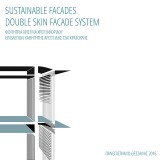The environmental impact of buildings constitutes an issue of great concern, necessitating immediate solutions which will promote the energy efficient systems in the construction field. The application of the double skin façade system occupies a prominent position among the possible practices of sustainable design. The first references to the system are observed many years ago, although it’s establishment attracted significant interest during the last decades.
The principles of the double skin façade concept are based on the installation of a second building skin which acts as an additional insulating layer, protecting the indoor conditions from the outdoor extreme temperatures. The function of the double skin façade relies on the exploitation of the solar gains during winter and on natural ventilation in combination with shading during summer.
Due to the system’s complexity and direct link with outdoor climatic conditions, according to the literature, there are many classifications and limitations. In case of improper design and type selection, the energy consumption will be increased while the indoor conditions will not be suitable for building users.
The aim of this research project is to extensively describe the double skin façade system aspects and examine its effectiveness in the region of Thessaloniki, in Northern Greece. For this reason the simulation software "Design Builder" was used. In order to acquire a profound understanding of the system operation, the first chapters of the project, concern the historical and technological development while also its structure and typology are described. Furthermore, the disadvantages and advantages are compared with mentioned examples of real building applications. The ultimate purpose was to evaluate the system performance in Greek climatic conditions, therefore headquarters with double skin façade were designed and simulated in the area of Thessaloniki. Finally, the extracted results were analyzed and discussed.
